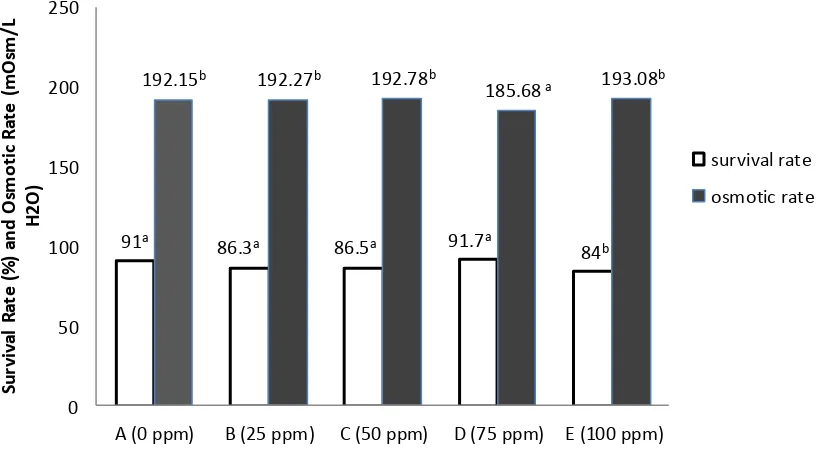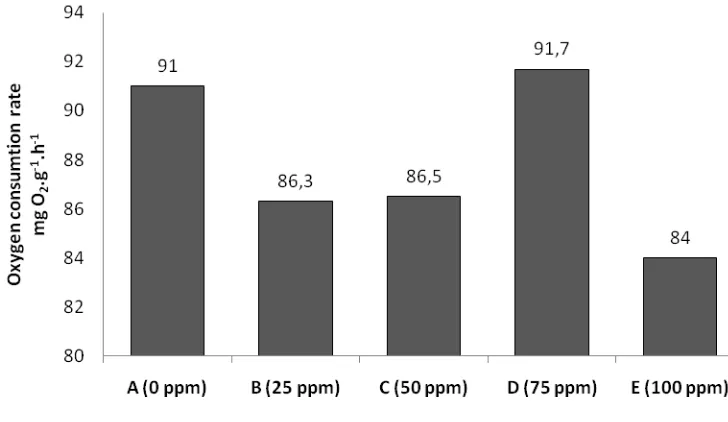Quality Improvement of Giant Freshwater Prawns (Macrobrachium rosenbergii) Postlarvae in Swamp Media with Addition of Sodium during the Acclimatization
Ferdinand Hukama Taqwa1,3*, Ade Dwi Sasanti1,3, A.K. Gaffar2,3, Yuri Amiro Hitosi1,3 1
Aquaculture Study Program, Faculty of Agriculture-Sriwijaya University Jl.Raya Palembang-Prabumulih KM 32, Indralaya, Ogan Ilir, South Sumatera
e-mail :[email protected]
*
Corresponding author : Telp. +6281367088484 e-mail: [email protected]
2
Research Institute of Inland Fisheries (BP3U)-Ministry of Marine Affairs and Fisheries Republic of Indonesia
Jl. Beringin 308, Mariana-Palembang
e-mail : [email protected]; [email protected]
3
Research Center for Sub-optimal Lands (PUS-PLSO)- Sriwijaya University Jl. Padang Selasa No. 524, Bukit Besar Palembang 30139
e-mail: [email protected]
ABSTRACT
The purpose of this study was to improve the quality of giant freshwater prawns postlarvae with
the addition of sodium during the acclimatization medium from 12 ppt until 0 ppt. This research
used Completely Randomized Design with 5 treatments and 3 replicates. The treatments of
addition sodium were 0 (A); 25 (B); 50 (C); 75 (D) and 100 ppm (E) by using swamp water
diluent. Experiment parameters included survival rate, oxygen consumption rate, level of
osmotic work and water quality. The results indicated that the survival rates of giant freshwater
prawns postlarvae were not significantly different among the treatments (varied from
84-91.7%). The osmotic levels were significantly different, with treatment on D can produce level of
osmotic work on postlarvae more lower with a value of 185.68 mOsm/l H2O. Oxygen
consumption rates also the best on treatment D that showed 1.378 mg O2.g-1.h-1. These results
showed that the addition or without addition of sodium did not significantly affect the survival
rate of giant freshwater prawns postlarvae, whereas osmoregulation (level of osmotic work) and
metabolism mechanism (oxygen consumption) can add as much as 75 ppm sodium in swamp
water. Water quality during acclimatization was still in range appropriate range to survival rate
of giant freshwater prawns postlarvae.
Keywords : sodium, giant freshwater prawns postlarvae, survival rate, osmotic level, oxygen
INTRODUCTION
Giant freshwater prawn (Macrobrachium rosenbergii) is a freshwater shrimp that has a
fairly high economic value and potential for propagation. According Hadie et al., (2001), that
84.65% of the waters in the South Sumatera has potential become aquaculture media. This is
due to the characteristics of the waters in the South Sumatera meet the natural habitat of giant
freshwater prawns. The main problems in aquaculture are the low rate of survival and growth in
the larval stage. Increased vitality prawns could measure from oxygen consumption rate and the
level of osmotic work. This is due to the larval stage is critical stadium that is affected by water
quality. One of water quality affecting the survival and growth rates of prawn is changes in
salinity at the migration time. The results of Charryani (2007), states that when the salinity
reduction made at the prawn larvae of 29 to 49 days old, salinity of 12 ppt to 0 ppt, best survival
value is 20.67%.
Therefore, it is necessary to enhance acclimatization method that can reduce mortality
rate and improve the survival rate. Acclimatization obtained done by the addition of sodium
during the salinity reduction. The addition of sodium is expected to increase the survival rate of
prawns postlarvae phase.
MATERIALS AND METHOD
The larvae of giant freshwater prawn used were 30 days living (stadium 11th) at 12 ppt
salinity which fed Artemia salina naupli. The acclimaztization of giant freshwater postlarvae
used aquarium measures 40 x 40 x 40 cm3, totally 15 pieces. Aquarium placed randomly
according to treatment. Each aquarium were aerated by using aerators for 24 hours so that the
dissolved oxygen content is ideal for larvae (5-7 ppm). Swamp water used as medium salinity
diluent, origin from the swamp water flood in the area of the hatchery of Aquaculture Study
Giant freshwater prawns postlarvae had used passed initial preservation in the
laboratory. Stocking densities prawns are 200 individuals per aquarium at 12 ppt salinity water
as much as 4 liters. Decrease in salinity of 12 ppt to 0 ppt by adding swamp water that has been
mixed with sodium (NaCO3) done gradually by arrangement through the faucet drip. Decreased
salinity dilution method for 10 days gradually. Decreased salinity are from 12 ppt, 10 ppt, 8 ppt,
6 ppt, 4 ppt, 3 ppt, 2 ppt, 1.5 ppt and 1 ppt. Then turn the water followed by 25% and 50% of
the total volume to obtain salinity of 0 ppt periodically 24 hours. The 1st day decreases to 10 ppt
salinity, next the 2nd day decreased salinity of 8 ppt and 6 ppt salinity reduction done on 3rd. The
4th day decreased salinity 4 ppt, further after reaching 3 ppt on 5th day done drop back to 2 ppt
salinity on 6th day. Decreased salinity of 1.5 ppt on 7th day and 1 ppt on 8th day. Next on the
salinity of 1 ppt done water changes as much as 25% of the total volume. Decreased in salinity
to 0.5 ppt performed on 9th day. At the turn of the 10th day of water that was done gradually 12
liters for 24 hours and salinity gained 0.5 ppt change of water for 24 hours by 50% and gained 0
ppt. The data of survival rate and osmotic level were analyzed statistically (ANOVA), while the
other parameters (oxygen consumption rate and water quality) descriptively analyzed.
RESULTS AND DISCUSSION
The osmotic work level is the result of osmotic difference of osmolarity prawns postlarvae
with medium osmolarity. The activity rate regulates osmolarity osmotic haemolymph of the
prawns. Figured 1 showed the survival rate of giant freshwater prawns postlarvae during the
acclimatization period was not significantly different to the levels survival rate of prawns. The
highest survival rate in the D treatment with the addition of sodium as much as 75 ppm.
Dersjant-Lli et al., (2001) states that the value of Na+/K+ ratio contained in the water functioned
to maintain appropriate balance between the K+ and Na+ ion in appropriate intraseluller liquid.
Survival rates were higher during the acclimatization period allegedly can cause decreased
91a
*different superscript behind data value on same color of chart show significant differences
survival rate
osmotic rate
The osmotic rate shows the activity rate is the lowest osmotic on treatment D with the
value of 185.68 mOsm.l H2O-1, while the highest levels of osmotic on treatment E (193.08
mOsm.l H2O-1). The addition of sodium with different treatment causes the osmotic work prawns
postlarvae were significantly different during the 10 days acclimatization of reducing salinity
period (based on Anova and Duncan’s Test). Based on the results Abidin (2011), low levels of
osmotic work associated with the level of oxygen consumption, the lower of osmotic energy use
osmoregulation in prawns postlarvae can be utilized for the growth process. The water
absorption ions such as Na, Ca, and Cl absorbed by the body through the gills. Ion settings
generally require a lower the energy which close to isoosmotic environment, so that the energy
can be used for growth enhancement (Imsland et al, 2003).
Figure 1.The graphic of survival rate and osmotic work of giant freshwater prawn postlarvae
Rate of oxygen consumption on Figure 2 can be used as a parameter to determine
metabolic rate aquatic organisms. Oxygen consumption rates affect energy use. Abidin (2011)
energy use for the metabolism of shrimp. The lowest oxyen consumption rate on treatment D
(1,378 mg O2.g-1.h-1) shows that additon of sodium as much as 75 ppm can reduce energy using
to metabolism, so growth energy of giant freshwater prawn postlarvae more higher than the
other treatments.
The treatmeants (sodium addition)
Figure 2. Oxygen consumption rate of giant freshwater prawn postlarvae
Based on Table 1, shows the temperature of all treatments during the study ranged from
26-300C. According Hirono (1982) in Abidin (2011), the optimal temperature for growth of
freshwater prawn between 28-320C. Temperature affects the rate of metabolism in animal
waters. The degree of acidity (pH) during the study ranged from 6.4-6.8. According Syafe'i
(2006), the optimal pH is in the range 7.0-8.5, while based on this study under the range of
optimal pH range of prawns, it is alleged by the addition of diluents swamp water causes a
decrease in pH during acclimatization period of prawns postlarvae.
Alkalinity value during acclimatization prawns at the beginning of period on all treatments,
are 82 mg.l-1, at the end of the period the value of alkalinity in treatment A, B, and C are 26
Value for ammonia measurements showed decreased during the study. The high ammonia
value can cause death in prawns (Syafe'i, 2006). Dissolved oxygen during the study is still in the
range of optimal care of giant freshwater prawn. Syafe'i (2006) said that for rearing, the optimal
range of dissolved oxygen for prawns is range 5-8 mg.l-1. Wynne (2000) and Cheyada et al.
(2001) states that the optimal conditions for breeding prawns are : water temperature between
28-320C, pH 7.2-8.4, dissolved oxygen at least 3 mg.l-1. Ahmad (2005) states that giant
freshwater prawns will be able to grow well if it is cared in medium temperature of 28-310C,
dissolved oxygen above 3 mg.l-1, pH 6.5 to 8.8 and ammonia content below 1 mg.l-1.
Table 1. The measurements of water quality on acclimatization media
Treatment
and oxygen consumption rate that more efficiency with sodium addition on swamp water diluent
ACKNOWLEDGEMENTS
The research was funded by Research Incentif of National Innovation System, Ministry for
Research and Technology 2012. We would also like to thank to Agriculture Faculty of Sriwijaya
University for the infrastructure of swamp area to elliminate this study, Research Center for
Sub-optimal Lands (PUS-PLSO) Sriwijaya University and Research Institute of Inland Fisheries
(BP3U) for the support of this experiment.
REFERENCES
Ahmad, Y. 2005. Biology and ecology of Macrobrachium rosenbergii. Macrobrachium
rosenbergii aquaculture management, Malaysian Technical Cooperating programme,
National Prawn Fry Production and Research Centre, Malaysia, p. 25
Abidin, J. 2011. Penambahan Kalsium untuk meningkatkan kelangsungan hidup dan
pertumbuhan juvenile udang galah (Macrobrachium rosenbergii de Man) pada meda
bersalinitas. Tesis. Sekolah Pascasarjana. Institut Pertanian Bogor. Bogor.
Charryani, E. 2007. Kelangsungan hidup dan Pertumbuhan udang galah (Macrobrachium
rosenbergii de Man.) (D21 - D49) pada berbagai tingkat penurunan salinitas. Skripsi.
Fakultas Pertanian. Universitas Sriwijaya.
Cheyada, D., C. Chitmon & C. Orachunwong. 2001. Hatchery of giant freshwater prawn in
Thailand. Charoen Pokphand Foods Ltd., Bangkok. Internal Extension Paper, 9 pp
Dersjant-Li, S. Wu, M.W.A. Verstegen, J.W. Schrama, and J.A.J Verreth. 2001. The impact of
changing dietary Na/K ratios on growth and nutrient utilization in juvenile African catfaish,
Clarias gariepinus. J. Aquaculture. 198:293-305
Hadie,W., L.E. Hadie, I.Muljanah dan Murniyati.2001. Tingkah laku makan dan molting pada
udang.Prosiding Workshop Hasil Penelitian Budidaya Udang Galah. Jakarta 26 Juli
Imsland A.K.S, A. Gunarsson, S.O.Foss, Stefansson. 2003. Gill Na+, K+/ATPase activity,
plasma chloride and osmolality in juvenile turbot (Schopthalmus maximus) reared at
different temperature and salinities. J Aquaculture 218:671-683.
Syafei, L.S. 2006.Pengaruh beban kerja osmotik terhadap kelangsungan hidup, lama waktu
perkembangan larva udang galah dan potensi tumbuh pascalarva udang galah. Disertasi
S2. Institut Pertanian Bogor. Bogor.
Wynne, F. 2000. Grow-out culture of freshwater prawn in Kentucky. Kentucky State Universty


